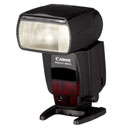Canon EOS 5D review – long term test
-
-
Written by Gordon Laing
Canon EOS 5D design
At first glance the Canon EOS 5D comes across as a beefed-up version of the 20D or 30D. Measuring 152x113x75mm and weighing just under 900g with battery, it’s only slightly larger and heavier, with just the higher Pentaprism head and lack of popup flash to really differentiate it.
|
The 5D is pictured above alongside the sheer bulk of the high-end 1Ds Mark II and the relatively tiny 350D / Rebel XT. When discussing the 5D, it’s important to note it’s not just the most affordable full-frame body yet, but clearly also the smallest. It’s substantially more portable and discrete than the considerable heft of the 1Ds Mark II which measures 156x157x80mm and weighs over 1.5kg with its battery.
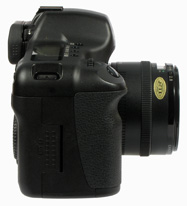 |
In terms of build quality the 5D feels essentially the same as the 20D / 30D bodies, although bereft of a popup flash, the head section is arguably tougher. Like the 20D / 30D, the 5D body feels very solid and comfortable to hold with key surfaces coated with Canon’s traditional mottled rubber finish for durability and grip. It has to be said Nikon’s D200 and D2X ultimately feel more robust while also sporting a preferable hooked grip design, but we certainly have no complaints over the 5D’s build, nor its ability to stand up to the knocks.
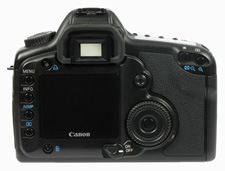 |
Anyone familiar with the 20D or 30D bodies will feel immediately at home with the control layout of the 5D which is dominated by the same thumb-operated command wheel on the rear. This navigates menus and cycles through various settings and is both tactile and intuitive to use; we personally much prefer it to the control system of the 1Ds Mark II.
The wheel itself can be disabled or enabled depending on the position of the three-way power switch to its lower left, although most will leave it active. In this position it can be used to adjust exposure compensation in all but Manual mode, where it instead controls the aperture.
Again like the 20D / 30D, most of the key controls are located on the top surface. The main command dial on the left side immediately positions the 5D as a more serious camera by shunning the scene presets of cheaper bodies. Instead, you’re only offered the traditional modes of Fully Auto, Program, Shutter and Aperture Priority, Manual and Bulb, along with a Custom option. Shutter speeds range from 1/8000 to 30 seconds plus Bulb, while the fastest flash sync speed is 1/200.
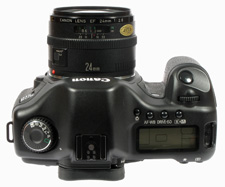 |
To the right side, three buttons above the backlit LCD status screen adjust a pair of settings each, with either a turn of the rear command wheel, or the finger wheel by the soft-touch shutter release.
The left button adjusts the three autofocus modes (One Shot, AI Focus and AI Servo) and the nine white balance options (including both custom and user-selectable temperatures between 2,800 and 10,000K).
The middle button adjusts the three drive modes (single, continuous and self-timer) or the ISO sensitivity in third-stop increments. Standard ISO settings range from 100 to 1600, although a custom function – see later – extends the range from 50 to 3200 ISO. Finally, the right button selects between the four metering modes of centre-weighted, spot, partial and evaluative, along with adjusting flash compensation between +/-2EV in third-stop increments.
The same scale on the upper LCD screen is used for both flash and exposure compensation adjustments, with the latter taking priority during normal operation. A small icon then reveals if any flash compensation has been set, but you’ll need to press the right button to actually check the value. Similarly you’ll need to press the middle button to reveal the ISO sensitivity. Other than the ISO and flash compensation values though, all other main settings described here, along with shutter, aperture, picture quality, battery life and remaining shots are shown at all times.
Nestled in the top right corner on the back of the camera just behind the status screen are the exposure lock and focus point buttons. The latter offers manual selection of the nine focus points, using a guide temporarily shown on either the LCD status screen or superimposed through the viewfinder. Both buttons double-up as zoom controls during playback.
Canon EOS 5D connectivity and battery
Two tall rubber flaps on the left side of the body hide the 5D’s connectivity options. Behind the left flap are the PC Sync flash port and a plug for an N3-type remote control. Behind the right flap are a USB-2 port and video output. Wireless connectivity is possible with the optional WFT-E1 module which screws to the base of the body. There’s no option for audio recording, and unlike the Nikon D200, no GPS connectivity either.
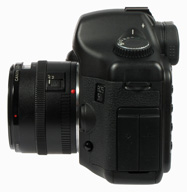 |
The 5D’s powered by a single BP-511A Lithium Ion battery pack and supplied with a mains recharger. The pack’s rated at 1390mAh and Canon claims it’s good for 800 shots at 20 degrees Celsius under CIPA testing conditions. Like other Canon DSLRs, the battery life is indicated by a two segment icon alone which begins to flash when you’re close to expiring.
We found the BP-511A could effectively deliver several days of fairly intensive shooting in a travelling environment. We also heard from owners who’ve lasted entire two week holidays without the need to recharge.
That said, it all depends on your environment and conditions. Fit a hungry image stabiliser lens and shoot all day at, say an air-show, and the battery will of course drain much faster. Similarly the sub-zero conditions we experienced when photographing the Aurora Borealis in Northern Norway – see Gallery pages – dramatically sapped our power, forcing us to shuttle a pair of battery packs back and forth to a charger in the car several times in one evening.
Overall though, the BP-511A in the 5D delivered an impressive performance. It’s just a shame there’s no finer indication of lifespan beyond full, half empty and ‘look-out, I could die at any moment’. Battery feedback is an area where Nikon’s taken the lead with the D200, although it’s still not a perfect implementation. Note the 5D can also use older BP-511 packs, but we found the resulting lifespan was greatly reduced.
The optional BG-E4 provides a portrait grip and room for two BP-511As for extended life, or supports six AAs if you’re really desperate.
